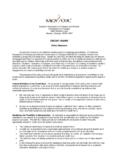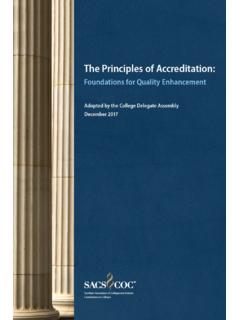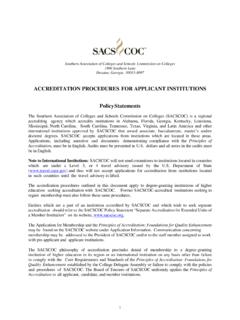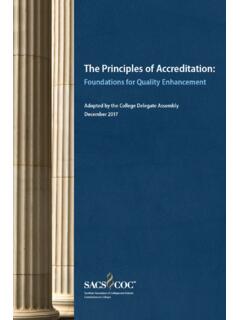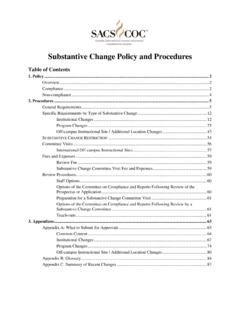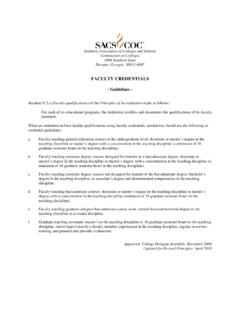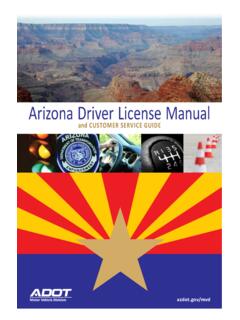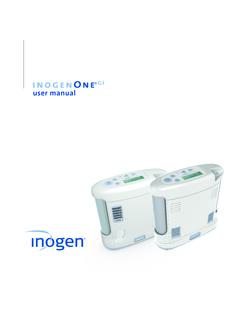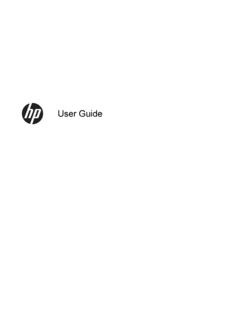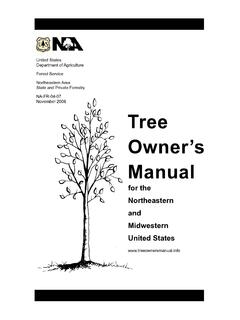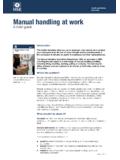Transcription of for The Principles of Accreditation - SACSCOC
1 RESOURCE manual . for The Principles of Accreditation : Foundations for Quality Enhancement Southern Association of Colleges and Schools Commission on Colleges 2020 Edition RESOURCE manual . for The Principles of Accreditation : Foundations for Quality Enhancement 1866 Southern Lane Decatur, GA 30033-4097. SACSCOC . Southern Association of Colleges and Schools Commission on Colleges Third Edition Published: 2020. Statement on Fair Use The Southern Association of Colleges and Schools Commission on Colleges ( SACSCOC ). recognizes that for purposes of compliance with its standards, institutions and their representatives find it necessary from time to time to quote, copy, or otherwise reproduce short portions of its handbooks, manuals, Principles of Accreditation , and other publications for which SACSCOC has protection under the Copyright Statute.
2 An express application of the Copyright Statute would require these institutions to seek advance permission for the use of these materials unless the use is deemed to be a fair use pursuant to 17 USC 107. This statement provides guidelines to institutions and their representatives as to what uses of these materials SACSCOC considers to be fair use so as not to require advance permission. SACSCOC considers quotation, copying, or other reproduction (including electronic reproduction) of short portions (not to exceed 250 words) of its handbooks, manuals, Principles of Accreditation , and other publications by institutions of higher education and their representatives for the purpose of compliance with SACSCOC 's standards to be fair use and not to require advance permission from SACSCOC .
3 The number of copies of these quotations must be limited to 10. Representatives of institutions shall include employees of the institutions as well as independent contractors, such as attorneys, accountants, and consultants, advising the institution concerning compliance with SACSCOC 's standards. By providing these guidelines, SACSCOC . seeks to provide a workable balance between an express application of the Copyright Statute, which may prove overly burdensome in some situations, and the right of SACSCOC to protect its creative and economic interests. These guidelines, therefore, do not constitute a waiver of any rights SACSCOC may have under the Copyright Statute. Table of Contents Preamble.
4 1. Organization of the 3. Important Considerations Applicable to The Principles Of 7. The Principles of Accreditation SECTION 1: The Principle of Integrity .. 11. SECTION 2: Mission .. 13. SECTION 3: Basic Eligibility Standards .. 15. SECTION 4: Governing Board .. 20. SECTION 5: Administration and 33. SECTION 6: Faculty .. 43. SECTION 7: Institutional Planning and Effectiveness .. 56. SECTION 8: Student 64. SECTION 9: Educational Program Structure and 76. SECTION 10: Educational Policies, Procedures, and Practices .. 90. SECTION 11: Library and Learning/Information Resources .. 107. SECTION 12: Academic and Student Support Services .. 112. SECTION 13: Financial and Physical 121.
5 SECTION 14: Transparency and Institutional 139. Appendices APPENDIX A: Chart of Standards .. 151. APPENDIX B: Glossary of Terms .. 154. APPENDIX C: Guidelines for Addressing Distance and Correspondence Education, Off- Campus Instructional Sites, and Branch 178. APPENDIX D: Documents of Special Significance for SACSCOC Institutions .. 185. APPENDIX E: Overview of Accreditation .. 188. Preamble The manner in which an institution makes its case for compliance with The Principles of Accreditation : Foundations of Quality Enhancement (the Principles of Accreditation or Principles ) is an institutional decision, and the process employed by a review committee to reach its decision on compliance issues is likewise determined by the professional judgment of that committee within the context of the institution's specific mission and circumstances.
6 The Resource manual is designed to (1) provide guidance to institutions as they seek to identify strategies for documenting compliance with SACSCOC requirements and standards and (2) be a resource in the training of review committee members and trustees as they strive to apply the Principles fairly and consistently. An institution's primary resource, however, is its SACSCOC staff member assigned to advise and to consult with the institution regarding the Accreditation process, its expectations, and applications. Such advice and information do not supplant the peer review process, but rather provide additional insight in helping institutions reach informed judgments about their self-assessments.
7 The Resource manual is intended to stimulate thinking when assessing compliance with the standards without prescribing a specific institutional practice or approach or providing a mandatory checklist to be followed. The comments are included to provide background for forming professional judgment regarding compliance. Many more factors could be taken into consideration, depending on the institutional context and the particularities of the individual situation. The manual is not intended to dictate a single institutional approach to evaluating and documenting compliance with a standard. While acknowledging the diverse nature of institutional missions and the range of educational programs represented within the membership of SACSCOC , the manual provides a rationale and notes, related suggested questions to consider, suggestions regarding appropriate types of documentation, and a cross-reference to other standards and to related policies and practices that an institution might consider as it assesses its compliance with those Accreditation requirements and standards.
8 The Resource manual is intended for use by institutions preparing for a reaffirmation review, fifth-year interim review, initial Accreditation , or substantive change review. For reaffirmation or initial Accreditation reviews, SACSCOC has also prepared handbooks to assist institutions in the development of documents: Handbook for Institutions Seeking Reaffirmation and the Handbook for Institutions Seeking Initial Accreditation . Institutions should refer to the respective handbook for specific information about preparation, development of documents, timelines, and so forth;. however, common review protocols are also addressed throughout this document. In all cases, the institution is responsible for documenting compliance with the Principles of Accreditation .
9 When doing so, it should consider the most appropriate ways for demonstrating compliance in light of its mission and then focus on presenting its case. The institution must incorporate into its review the assessment of compliance as it applies to distance and correspondence education and to off- campus instructional sites and/or branch campuses, where appropriate. This manual is a companion document to the 2018 Principles of Accreditation and is accurate as of January 2021. Changes to the standards or to interpretations made after this date may supersede some of the contents of this manual . Resource manual for The Principles of Accreditation : Foundations for Quality Enhancement 1.
10 Organization of the manual The Resource manual examines all 14 Sections of the Principles of Accreditation . In an institution's Compliance Certification, or other SACSCOC templates used by the institution for reporting compliance, documentation of compliance with Section 1 (Integrity) is not required;. however, for each standard that requires an institution to submit documentation of compliance in Sections 2 through 14, this Resource manual addresses the following: The Standard The wording of each standard is repeated as it appears in the Principles of Accreditation (2018). In some instances, the stem of the standard is repeated for clarity. In a Compliance Certification, the institution, through its own internal review process, will make its determination of its compliance with the standard.

